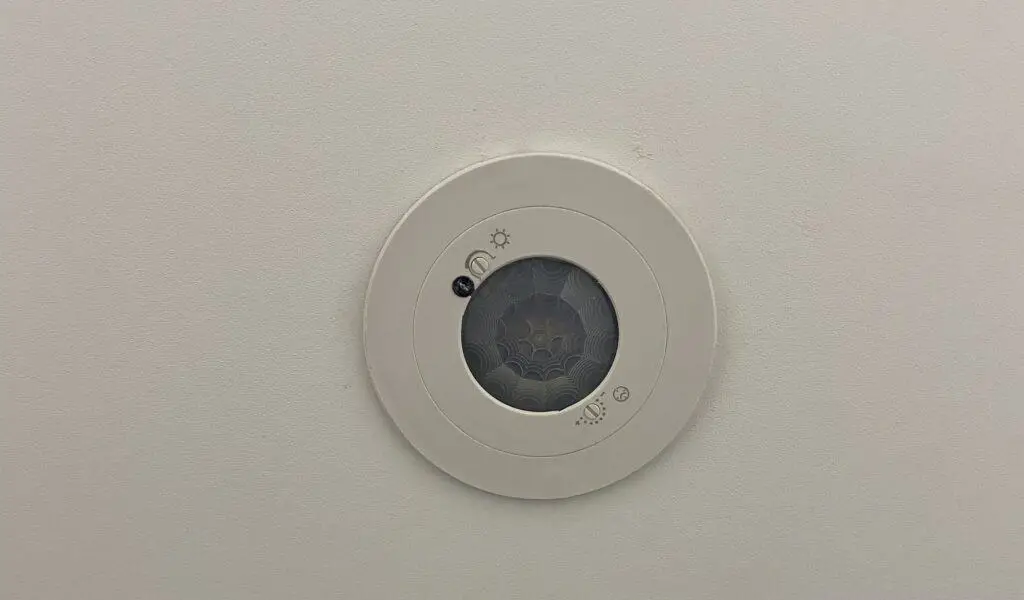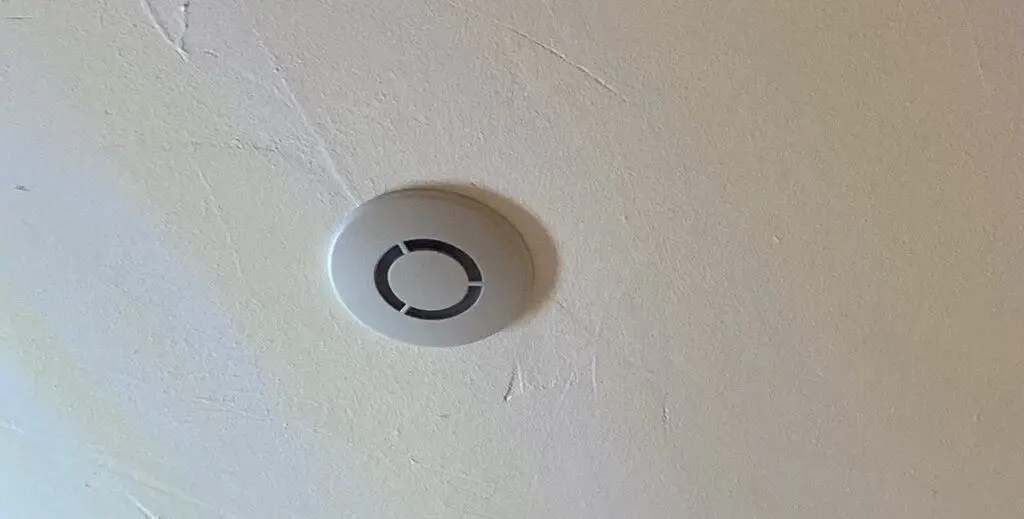Whilst motion sensor-controlled lighting is great in many circumstances, there are few things more annoying than a motion sensor triggering unwantedly. Whether it is an exterior light, whose constant triggering is keeping you up all night, or it is a hallway sensor being triggered by the cat, a convenient piece of technology can be a real nuisance to fix.
As an electrician, I have turned up to a customer’s address and discovered that they have put some sort of tape over the sensor in an effort to fix it. The question is, does putting tape over a sensor stop it from triggering? I’ve questioned quite a few people about the effectiveness of this method so I feel in a good place to comment.

Tape can be effective as a short-term solution to prevent a motion sensor from triggering but it can also damage the sensor. PIR sensors are more likely to be disabled by common tape whereas microwave sensors need a certain type of tape.
We can see that unfortunately the answer is not straightforward and it depends on the type of motion sensor we are dealing with. Different types of sensors work in different ways, while some motion sensors work by detecting changes in heat, others work by detecting movement.
If we are dealing with a motion sensor that uses heat detection, such as a PIR (passive infrared) sensor, then tape may be able to block the sensor. However, if we are dealing with a motion sensor that uses movement detection, such as a microwave sensor, then the tape is unlikely to be as effective.
Does Tape Work as a Barrier Against Motion Detection?
Microwave sensors are more sensitive than PIR sensors. Microwave sensors can detect movement through walls and through glass so stopping the detection by tape is more of a challenge and relies more on the type of tape used as mentioned further down the post.
If you are unsure of the type of sensor you have, a rule of thumb I find useful is that a lower profile and higher priced point motion sensor is likely to be microwave sensing. This doesn’t always follow true but is a good guide in my experience.

Although we are likely to have more success putting common tape on a PIR sensor than a microwave sensor, due to the relatively cheap nature of tape it may be worth giving it a go and seeing if it solves the problem. If it doesn’t work, opting for the more expensive metallic tape may be needed.
Different types of tape are more suited to the task. The location of the sensor will also play a part as certain types of tape don’t do very well exposed to the elements.
Types of Tape We can use to Try and Block a Motion Sensor
There are several types of tape that may be effective at blocking microwave and PIR sensors.
| Electrical tape | Electrcial tape is made of vinyl and has a sticky backing that adheres well to most surfaces. Electrical tape is relatively thin, so multiple layers may be required to effectively block signals. This tape isn’t great when exposed to the elements and rain tends to make it fall off. |
| Metallic tape | Duct tape is a common type of tape used for a variety of applications, including sealing boxes and repairing household items. While duct tape may be effective at blocking some types of signals, it may not be as effective at microwave signals. Duct tape holds up well against the elements but also leaves a lot of residues when you try to remove it. |
| Duct tape | Duct tape is a common type of tape used for a variety of applications, including sealing boxes and repairing household items. While duct tape may be effective at blocking some types of signals, it may not be as effective at microwave signals. Duct tape holds up well against the elements but also leaves a lot of residue when you try to remove it. |
Thickness of Tape Used Makes a Difference
The thickness of tape that is required to effectively block motion sensor signals will depend on a variety of factors, but in general, opting for a thicker tape will be more effective at blocking motion sensor signals than thinner tape.
If we are taping over a PIR sensor it makes sense to add a few layers of tape. With microwave sensors, the correct type of tape appears more important than the thickness of that tape.
For microwave sensors, effective shielding would appear to be a better option. By using reflective tape, such as the metallic tape mentioned in the table above, we stand a much better chance of preventing unwanted triggers.
“The thickness of the material is not so important with reflective microwave shielding since it works by reflection, i.e. on the surface. Aluminum and copper are excellent materials for this type of shielding, though any metal can be used.”
Article link here, discussing reflecting microwave signals to prevent them passing through objects
Effectiveness of Tape at Blocking Motion Sensor Signals
Using tape may not be the best long-term solution but can help solve the annoyance of the constant triggering light until a proper fix can be arranged. I’m not suggesting that tape is a bodge, but I’m not sure many handymen would be proud to show off their work with the roll of tape!
The type of tape used is a significant factor in determining its effectiveness. Some tapes, such as aluminium foil tape and copper tape, are better at blocking microwave signals. Additionally, the thickness and width of the tape can impact its effectiveness. A thicker and wider tape is more likely to block PIR signals than a thinner and narrower one.

Safety Considerations
It is important to note that attempting to stop any type of motion sensor from triggering by using tape or other material is not really recommended. Doing so may cause the sensor to malfunction. If the sensor is already malfunctioning this may be ok as a temporary fix until it can be replaced.
If we are planning to cover the sensor with tape for a short period and then use the sensor again this is likely a bad idea and the sensor may stop working.
We should also point out that tape or any other material used to cover or obstruct a motion sensor may cause it to overheat, leading to damage or even fire. We must always follow the manufacturer’s instructions and guidelines when installing and operating motion sensors to ensure their proper functioning and safety.
Alternatives to Tapping Over a Motion Sensor
While tapping over a motion sensor may seem like a simple solution, there are other alternatives, more permanent fixes that we can try. Getting out the roll of tape may seem like a good idea, but using one of the fixes below is likely to be more permanent and save hassle in the long run.
| Use override switch | the majority of motion sensors allow you to adjust the sensitivity level. If the sensor is being triggered by small movements or objects, you can try decreasing the sensitivity levels to see if it helps. |
| Adjust the sensitivity | the majority of motion sensors allow you to adjust the sensitivity level. If the sensor is being triggered by small movements or objects, you can try decresing the sensitivity levels to see if it helps. |
| Use a remote control | If you don’t want the sensor to detect motion in a certain area, you can try blocking it with an object. Keep in mind though that this will work for PIR sensors but not microwave ones as they can detect through objects. |
| Block the sensor | If you don’t want the sensor to detect motion in a certain area, you can try blocking it with an object. Keep in mind though that this will work for PIR sesnors but not microwave ones as they can detect through objects. |
It’s important to remember that this article is dealing with motion sensor-controlled lighting. Other types of motion sensors, especially those used in security, are likely to have alarms built into the system to know that they are being tampered with if they are covered or obstructed. taping over these types of sensors is a bad idea and not recommended!
Finally, if in any doubt about the safety of your electrical equipment, it is important to contact a local electrician who can carry out tests to ensure the wiring systems are safe. Taping over a sensor may seem like a simple fix, but the sensor’s constant triggering may be a symptom of a bigger problem that should be investigated by a professional electrician.

